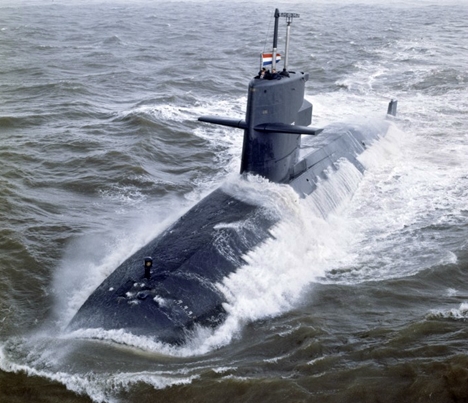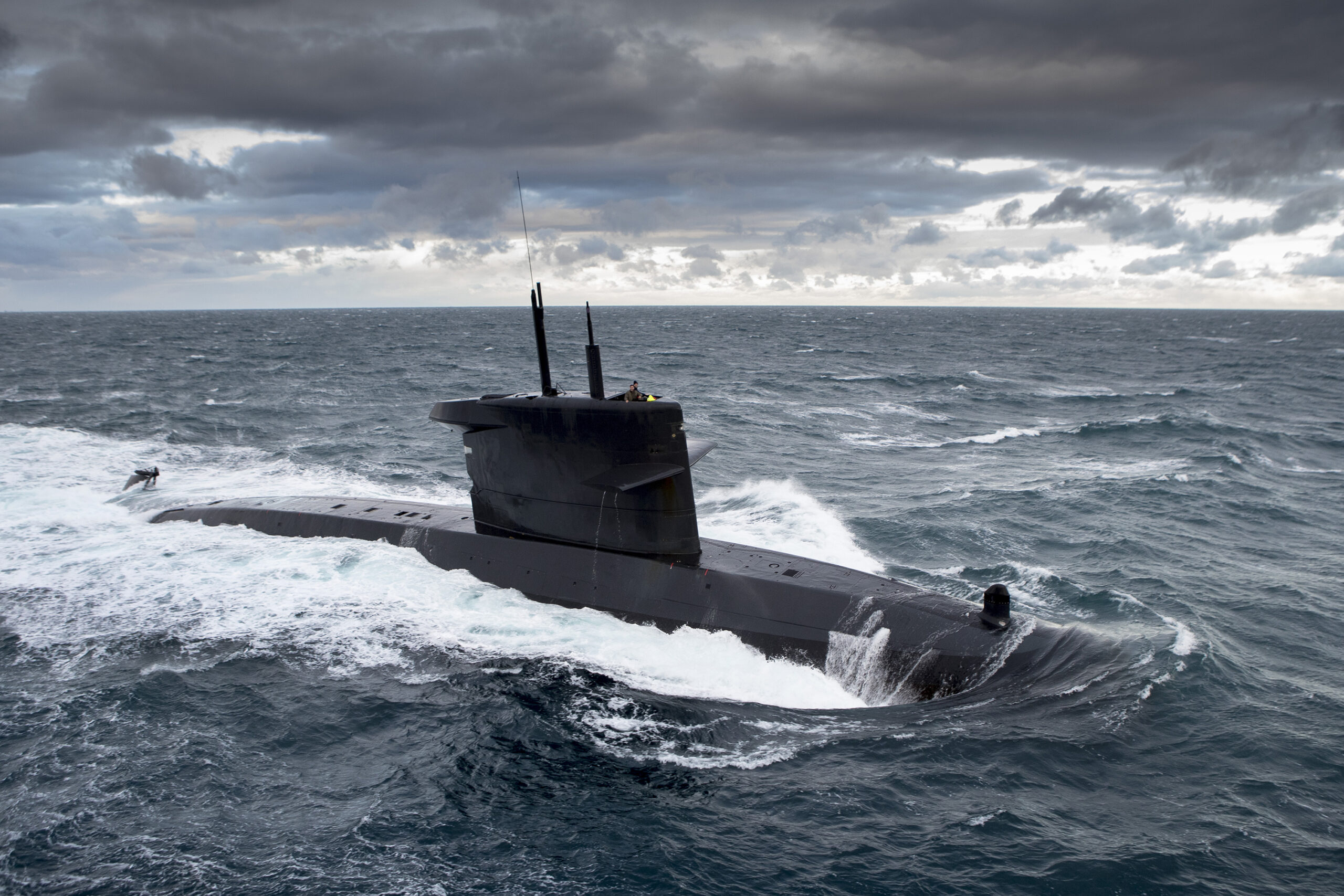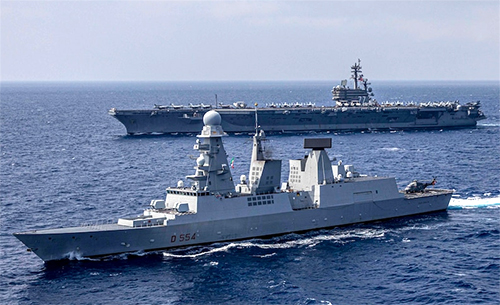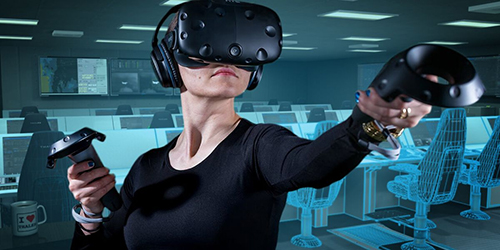Overhauled Dutch frigate prepares for major test
A lot of work has been done on Dutch frigate HNLMS De Zeven Provinciën to modernize the ship. Marineschepen.nl visited the frigate that is working hard towards an important milestone in the participation of the ‘missile shield’ against ballistic missiles: At Sea Demonstration 2021 later this year. That is the focus, but much more has been renewed and changed inside the nearly 20-year-old ship.
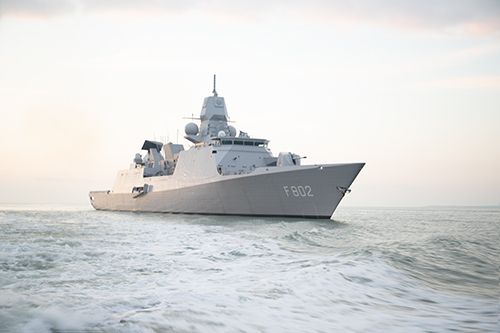
Marineschepen.nl was on board modernized frigate HNLMS De Zeven Provinciën. (Photo: Jaime Karremann / Marineschepen.nl)
The Air Defence and Command Frigate (LCF) HNLMS De Zeven Provinciën is still as gray as when the ship was put into service in 2002. Like then a large black radar is rotating on the hangar and the 127mm gun, eagerly looked at by museum directors, is still on the forecastle. So nothing has changed.
“For us it is really a new ship, so much has changed”, an employee of the Dutch MoD software department Maritime IT tells to your reporter in the gangway, while stewards take large containers of food from the elevator to the officers’ mess.
It sounds a bit strange, ‘new ship’, because the LCF does not seem to have changed much on the outside, nor on the inside. But appearances can be deceiving. The LCF Upkeep Program (IP LCF) is a major modernisation project that is most visible on a technical and operational level. IP LCF consists of 41 subprojects that will ultimately deliver a new bridge, new Command and Information Centre (CIC), new ballast water treatment system, the new Thales SMART-L MM / N radar, 24 km of new cables and more than 1,000 new devices.
“I think it is easier to build a new ship than to strip a ship completely empty and fill it with new equipment,” said Commanding Officer of De Zeven Provinciën, captain Bob van Hoof a little later in his cabin. “For example, all computers in the CIC have been replaced”, Van Hoof continues. “The tricky part is that very old equipment, such as the old Harpoon installation with the bakelite buttons, must be connected to the new systems. Such a network must then ‘speak’ various old and new languages, which must also be synchronized. That is a challenge to integrate.”
“That is why we are doing tests at sea for weeks,” adds Head of Operational Branch lieutenant Kevin Stolk. “Maritime IT is in our CIC and is constantly updating the CMS to do that integration as well as possible, so that the system will soon work as well as possible.” And what the system has to do is, for the first time all by itself, detect and track ballistic missiles in space. That is the goal for everyone who is involved in Dutch BMD-programme. But first about the new stuff of the ship.
Technology on the bridge
There is lots of new stuff on the bridge. This will strike anyone who has been on a bridge of the LCF before. The most visible changes: the chart table has disappeared and has made way for a large renewed console for the signallers. Here the signallers set up digital and voice connections thanks to new systems.
On the other side of the bridge, there is now a position for the Marine Engineering Officer, which has the new platform management software with all the information and options available. If a naval vessel is in narrow waters or if it is foggy, more people will come on the bridge, including the Marine Engineering Officer. He or she provides technical knowledge on the bridge, acts as an intermediary in communication between the Ship Control Centre and the bridge, and can advise the officer in the event of, for example, technical problems (which are very inconvenient in such a situation). of the guard or the commanding officer.
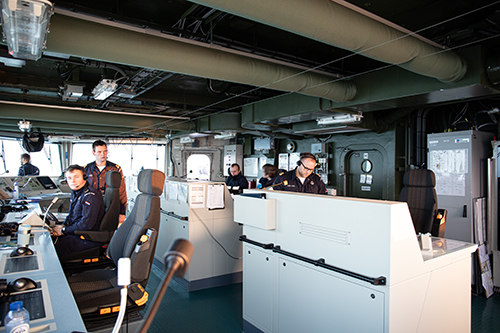
The renewed bridge. The positions on the left are for the commanding officer and the officer of the watch, and of course for the helmsman. The helmsman’s seat is higher than in the past and the front row is also positioned further forward. This was possible thanks to the smaller equipment. The two rear ‘islands’ are in front of the Head of Technical Branch (right), the signalers have the other position. (Photo: Jaime Karremann / Marineschepen.nl)
In the past, the Marine Engineering Officer only had a seat on the bridge and could talk to the Ship Control Centre. Van Hoof is pleased with the innovation: “The Marine Engineering Officer had to get all the information from the Ship Control Centre. That had a delaying effect and, moreover, you never had the total overview. Now the Marine Engineering Officer can see on his screen what the Ship Control Centre sees. For example, we had a problem with a certain propulsion system that shut down as soon as we turned hard. Thanks to the console, the crew on the bridge could keep an eye on the system and prevent the machine from shutting down. We can extract much more information from the system, so that in emergency situations we ask fewer questions to the Ship Control Centre who is then dealing with the calamity. We can also better anticipate possible problems, so that they occur less often. “
Standby, fix, click
The removal of the chart table has everything to do with the introduction of the digital chart, ECDIS. But the digital chart was already there, right? Van Hoof: “Yes, but because that chart was integrated in the CMS we were not allowed to use it, so we had to have a paper chart. We now have a system that is independent of the CMS.”
And the difference can be seen on the bridge. Of course because the chart table has been removed, but also because of the way in which the position of the ship is now determined on the basis of landmarks on the shore.
With a paper chart that is a very precise job that can take a while. Thanks to the electronic chart and the digital bearing compasses, which directly enter the bearing in ECDIS, it has become a quick bearing of three objects and some clicks of the mouse. This is so fast that nowadays the position can even be determined when the ship is turning.
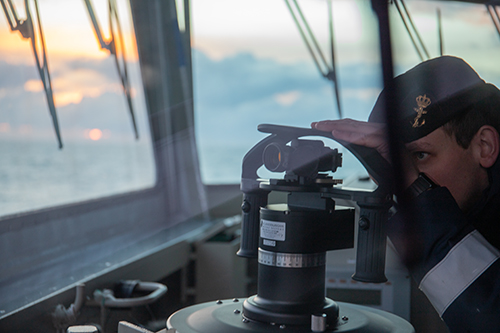
Digital bearing compass. These are actually binoculars with a button. Instead of reading the bearing aloud, now only a button on the device has to be pressed and the bearing is transferred to the digital map. (Photo: Jaime Karremann / Marineschepen.nl)
But wait a minute. Are we talking about positioning here? We’ve been using GPS for that since the late 1970s, right? Well, navies have indeed been using GPS for many years. However, it is also known that, for example, Russia has sometimes spoofed the GPS signal.
“Everyone nowadays sails and drives on GPS, the car industry is even completely switching to GPS,” says Van Hoof. “We turn off the GPS so that we also keep sailing safely by making visual fixes. We force our team to look outside. That is much more difficult than sailing on GPS, but you should always be aware that you can handle a situation in which you cannot use GPS. “
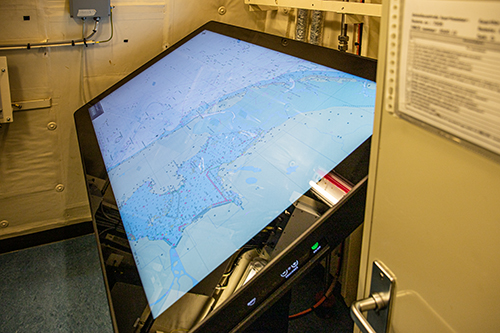
All screens have become larger, but this ‘super tablet’, which was made in collaboration with RH Marine, takes the cake. This is the chart room behind the bridge, where a chart table used to be. This screen, which works as a tablet, shows maps (which have been licensed) just like Google Maps. For example, the route to be sailed can be planned here and it can be used for briefings. (Photo: Jaime Karremann / Marineschepen.nl)
Change in navigation
Sailing with an electronic chart is really different. “In recent incidents where commercial ships ran aground, errors were often made with the electronic chart,” says Van Hoof. “They thought they were in safe waters. Sailing safely with a computer system is different because you have to pay attention to other things. A paper chart does not change, you can see everything at once, for example depth lines. You can set these on an ECDIS. But you do have to adjust the settings of the hazard depth line and keep checking. An error in the settings can run the ship aground “, says Van Hoof.
Another risk is the amount of alarms and information that is sent to the bridge team in some situations. Especially alarms that are not relevant (for example for a shallow area that is not really dangerous), can ensure that crew members are no longer alert to an alarm if something is really important. Information on a screen also appears reliable and complete, while it is sometimes better to just look outside. Van Hoof. “The somewhat older young people are used to looking outside more to assess a situation and are used to making decisions based on the outside image. The new generation looks at screens more quickly, there is a risk that they are too involved in the AIS, ECDIS and radar images. ”
“Ultimately, an ECDIS is much safer, because you can see your position much faster. And before that it was only visible in the map, the officer of the watch who looked through the window did not see that. Now you almost have a head up display. “
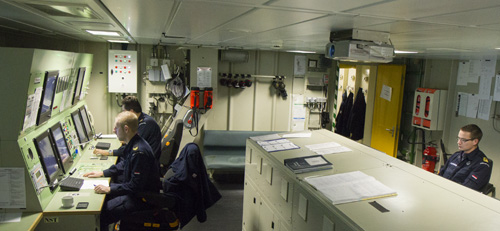
Unfortunately, no photos were allowed to be taken in the new Ship Control Centre. This is the old situation. More screens have been added to the screens to the left of the photo, especially with images of engineering spaces. The console on the right has been shortened and reduced to a smaller position. A new large console is located almost in the middle of the room. (Photo: Jaime Karremann / Marineschepen.nl)
Ship Control Centre
A long way down is the technical heart of the frigate, the Ship Control Centre. A major change can also be seen here. There are more and larger screens on which, thanks to a much larger number of cameras, the technical areas in the ship are shown much better. The most important improvement is not visible, that is the renewed Integrated Platform Management Software (IPMS) from RH Marine.
In this new version a lot of attention has been paid to user-friendliness and an automatic advisory function has again been included, which now plays a much larger role in the Ship Control Centre. The software can take over more tasks from the staff and an unmanned Ship Control Centre, just like on the Holland class OPVs, is not inconceivable in the future. How exactly everything will take shape is sometimes still to be figured out on board the De Zeven, as is also apparent from the words of Van Hoof: “A concept has been devised for how the Ship Control Centre should work, for example with an Marine Engineering Officer that is behind a large console and a personnel division that has been devised on paper. We now have to see whether it is as logical as expected in practice.”

The SMART-L MM / N, recognizable by the square pattern instead of the horizontal lines on the old SMART-L. This radar also features a new IFF with Mod 5, replacing Mod 4. In addition, the modernized Goalkeeper can be seen. De Zeven Provinciën is the first ship to fully integrate the new Goalkeeper into the CMS. It is also the first ship to work with the new Link 22. The Netherlands is one of the first countries to work with Link 22.. (Photo: Jaime Karremann / Marineschepen.nl)
Dot on the horizon: dot in space
On one important point, the LCF has made a huge step: Ballistic Missile Defence (BMD). A programme that began in the 1990s when these frigates only existed on paper. At the time, it was already understood by the designers that these ships could play a role in detecting and destroying ballistic missiles.
In 2006 LCF HNLMS Tromp demonstrated for the first time off Hawaii that, to the surprise of the Americans, it could detect ballistic missiles with the old SMART-L.
In 2019 the new Thales SMART-L MM / N was finally put on HNLMS De Zeven Provinciën and since then there has been one clear goal for the ship: At Sea Demonstration 2021 in May / June of this year. “That is the dot on the horizon for ship and crew,” says Van Hoof.
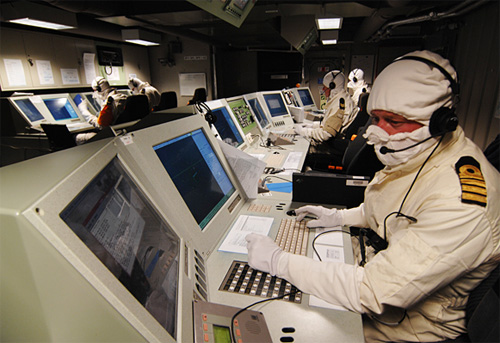
Old situation of the command centre, no photos were allowed of the new one. The interior has largely remained the same, but all hardware has been replaced. Instead of two screens, each position will have one large screen. (Photo: NL MoD)
New task, no extra people
Van Hoof is looking forward to ASD21. “Because this is the only radar in the world that can do BMD and air defence at the same time. In 2015 we also combined BMD and air defence with De Zeven, but that was thanks to a trick. The Americans have done the same in the past, but we will have this capability as a standard option on board.”
The new radar can detect missiles up to a distance of 2,000 km. Van Hoof: “I already thought the old SMART-L radar for air defence was good, we now see that the new radar can do a lot more than the previous one.” A pitfall is that the personnel in the CIC receive too much information, because the radar not only detects more, it also looks much further.
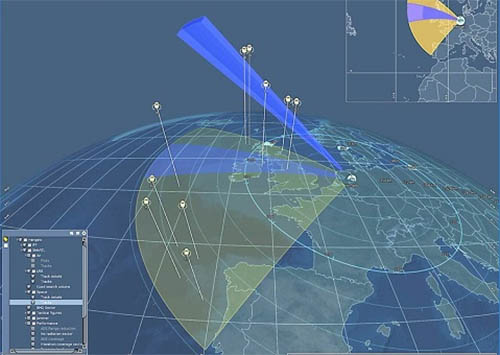
Representation of the radar beam of the test model of the SMART-L MM / N from Hengelo in 2017. The white icons are satellites. The beam has a range of 2,000 km and can thus image missiles near Spain, Northern Greece, from the North Sea. (Image: Thales)
In addition to a new radar, more is needed to be able to do BMD. The CMS, the software in the CIC, has also been updated and adapted to the new radar. BMD is built into the CMS and now displays a 3D image of the ballistic missile instead of a flat radar image. Despite all the new possibilities, the commanding officers of the LCFs have not been given any additional personnel.
Van Hoof: “BMD is something we have to do next to our normal work in the CIC. So we have to be efficient with the crew. They also have to receive the training to be able to use the BMD planner, for example [used to determine the best position for optimal detection, JK]. The BMD planner is important when we’re in a mission area, suddenly new intel comes in and we can’t wait for support from shore. Then we use the planner ourselves to determine the best position. That means training, and that means a workload distribution in the CIC and a different operational management. “
“A few years ago we came up with a concept for the CIC,” adds Stolk. “Now it has to become clear in practice whether it works, we adapt what does not. Ultimately we will arrive at what is workable for all future BMD naval ships.” In addition to existing personnel, the CIC also has to make do with the same number of display cabinets; there will be no separate BMD console. “We would have preferred it,” says Stolk, “but it is more a nice to have than a need to have.”
This article was first published in Dutch on Marineschepen.nl, March 2021.

